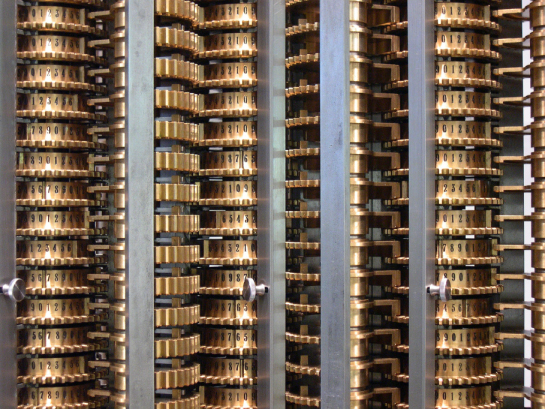History Of Information Technology¶
Introduction¶
Information technology has been around for a long, long time. Basically as long as people have been around, information technology has been around because there were always ways of communicating through technology available at that point in time. There are 4 main ages that divide up the history of information technology. Only the latest age (electronic) and some of the electromechanical age really affects us today, but it is important to learn about how we got to the point we are at with technology today.
Ages¶
Premechanical¶
The premechanical age is the earliest age of information technology. It can be defined as the time between 3000B.C. and 1450A.D. We are talking about a long time ago. When humans first started communicating they would try to use language or simple picture drawings known as petroglyths which were usually carved in rock. Early alphabets were developed such as the Phoenician alphabet.

Petroglyph
As alphabets became more popluar and more people were writing information down, pens and paper began to be developed. It started off as just marks in wet clay, but later paper was created out of papyrus plant. The most popular kind of paper made was probably by the Chinese who made paper from rags.
Now that people were writing a lot of information down they needed ways to keep it all in permanent storage. This is where the first books and libraries are developed. You’ve probably heard of Egyptian scrolls which were popular ways of writing down information to save. Some groups of people were actually binding paper together into a book-like form.
Also during this period were the first numbering systems. Around 100A.D. was when the first 1-9 system was created by people from India. However, it wasn’t until 875A.D. (775 years later) that the number 0 was invented. And yes now that numbers were created, people wanted stuff to do with them so they created calculators. A calculator was the very first sign of an information processor. The popular model of that time was the abacus.
Mechanical¶
The mechanical age is when we first start to see connections between our current technology and its ancestors. The mechanical age can be defined as the time between 1450 and 1840. A lot of new technologies are developed in this era as there is a large explosion in interest with this area. Technologies like the slide rule (an analog computer used for multiplying and dividing) were invented. Blaise Pascal invented the Pascaline which was a very popular mechanical computer. Charles Babbage developed the difference engine which tabulated polynomial equations using the method of finite differences.

Difference Engine
There were lots of different machines created during this era and while we have not yet gottent to a machine that can do more than one type of calculation in one, like our modern-day calculators, we are still learning about how all of our all-in-one machines started. Also, if you look at the size of the machines invented in this time compared to the power behind them it seems (to us) absolutely ridiculous to understand why anybody would want to use them, but to the people living in that time ALL of thse inventions were HUGE.
Electromechanical¶
Now we are finally getting close to some technologies that resemble our modern-day technology. The electromechanical age can be defined as the time between 1840 and 1940. These are the beginnings of telecommunication. The telegraph was created in the early 1800s. Morse code was created by Samuel Morse in 1835. The telephone (one of the most popular forms of communication ever) was created by Alexander Graham Bell in 1876. The first radio developed by Guglielmo Marconi in 1894. All of these were extremely crucial emerging technologies that led to big advances in the information technology field.
The first large-scale automatic digital computer in the United States was the Mark 1 created by Harvard University around 1940. This computer was 8ft high, 50ft long, 2ft wide, and weighed 5 tons - HUGE. It was programmed using punch cards. How does your PC match up to this hunk of metal? It was from huge machines like this that people began to look at downsizing all the parts to first make them usable by businesses andeventually in your own home.

Harvard Mark 1
Electronic¶
The electronic age is wha we currently live in. It can be defined as the time between 1940 and right now. The ENIAC was the first high-speed, digital computer capable of being reprogrammed to solve a full range of computing problems. This computer was designed to be used by the U.S. Army for artillery firing tables. This machine was even bigger than the Mark 1 taking up 680 square feet and weighing 30 tons - HUGE. It mainly used vacuum tubes to do its calculations.
There are 4 main sections of digital computing. The first was the era of vacuum tubes and punch cards like the ENIAC and Mark 1. Rotating magnetic drums were used for internal storage. The second generation replaced vacuum tubes with transistors, punch cards were replaced with magnetic tape, and rotating magnetic drums were replaced by magnetic cores for internal storage. Also during this time high-level programming languages were created such as FORTRAN and COBOL. The third generation replaced transistors with integrated circuits, magnetic tape was used throughout all computers, and magnetic core turned into metal oxide semiconductors. An actual operating system showed up around this time along with the advanced programming language BASIC. The fourth and latest generation brought in CPUs (central processing units) which contained memory, logic, and control circuits all on a single chip. The personal comptuer was developed (Apple II). The graphical user interface (GUI) was developed.

Apple 2
There is a lot more to all of these generations and ages but all you really need is a rough overview.